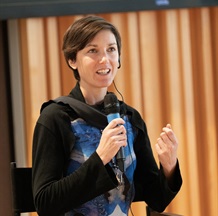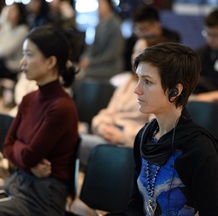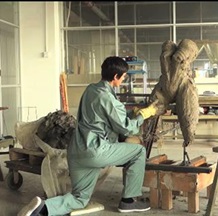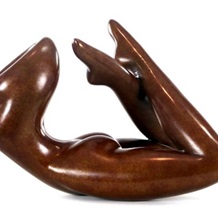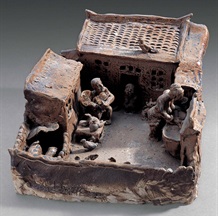Interview with Aima Saint Hunon
Date:
2020.01.15
The original title is "Aima Saint Hunon: The shape represents a constant change through her emotion and direct experiences"
As a French visual artist, Aima Saint Hunon is involved in multi-media art creation including sculpture, painting, photography, performance and video etc. In her works, she is always in the pursuit of forms and curves, revealing a sensuality similar to her own inner being. After numerous travel around the world, Aima applied herself to different materials such as terra cotta, wood, stone and bronze. She assembles these various materials in a dreamlike manner which appears both symbolic and magical.
On the occasion of the symposium held at the Columbia University featuring Liu Shiming and sculptural art in diverse cultural context, CAFA ART INFO specially invites Aima to have an interview. The conversation explored both Liu Shiming and Aima’s art in terms of forms and inner pursuits, as well as Aima’s encounter with China.
CAFA ART INFO: Hello Aima, thanks for your time. I was impressed by your words in the symposium today. Regarding Liu Shiming and your personal experience, I have several further questions for you. Firstly, after viewing Liu Shiming’s sculptural works in the Asian Culture Center, what is your overall feeling?
Aima: I did not know the artist Liu Shiming before, so for me, it was a new discovering. It was very interesting to learn about the chronology of his work, the period of China as well as what he created and designed. It was fascinating to see a Chinese-feeling sculptor at that time, who really talked about Chinese people and his country. When I viewed his works, I was sharing an emotional moment with the sculptures. For me, it was open-minded and a learning experience to know more about Chinese culture, artists and the social appearance of China in a particular period.
CAFA ART INFO: In the symposium, you mentioned the material Liu Shiming used that impressed you to a great extent. The selection of material is vital for an artist. From your perspective as sculptors from Western countries, can you elaborate the topic concerning material choosing furthermore?
Aima: I think he used the common materials in China at his period to express himself. He used mostly natural materials. Using clay as the medium, Liu expressed the inner portrayal of himself as well as millions of ordinary people in China. It is interesting to notice that he used bronze later just to secure his works as pottery is fragile. I think clay is the most sincere and pure material to express the unique soul of Chinese people.
As human beings, we all live and root on the earth. As a material, clay is primary and straightforward. It comes from the earth so that the creator can apply their most direct emotion to it. Liu Shiming transferred clay into an intermedia for freedom. The humanist spirit transmitted by his works has spanned languages, cultures and fields and has been passed on to viewers around the world. For me, apart from clay, I am also working with stone in Paris as well, because it is easy to get - these two materials are all around Paris, which can easily convey our instant emotions.
CAFA ART INFO: Compared to your or other Western artists’ art creation, what do you think is the uniqueness of Liu Shiming’s sculpture?
Aima: Although we all work with clay, we are different from the cultural background. I am much more influenced by Europen masters and western art history. In my perception, what Liu Shiming did was just to express his own feelings. Instead of being influenced by Western people, Liu utilized clay to empower his personal feelings on figures from his own countries. But I think we are kind of in common as we are working on our own cultures, emotions and experiences.
CAFA ART INFO: I learned that you had been exposed to ceramic and pottery art in Jingdezhen, Jiangxi Province, China before. How was this experience?
Aima: Yes, I spent two months in the factory there and I worked with them for two years. The two-month experience in the factory with Chinese people was unforgettable. I was in the porcelain factory only with Chinese people.
CAFA ART INFO: Based on your experience in Jingdezhen, do you think the Chinese elements have somehow influenced or shaped the development of your further art creation?
Aima: Yes, definitely. The experience changed the shape and meaning of my sculpture. In Jingdezhen, I tried to learn different techniques. I attempted to bring together French meaning and Chinese culture and combine them - some times they are similar and sometimes are different, so I made efforts to mix them. Also, during this experience, I was really working with Chinese artists who invited me to their studios for two years. At that time, I was with a Chinese team and worked with Chinese workers. I did not speak any French or English with them, eating and living like them. It was a long period of time, so I really tried to take my heart and feeling to learn their technique, and observe how they think of sculpture as well as their different consideration of earth. From my own perspective, many Chinese artists represent their life and people. Mostly they draw the characters for the first step and then transfer it to the 3D version. However, for my own part, I am much more emotional and always have different sculptural ideas inside.
CAFA ART INFO: So that means you normally apply your instant ideas directly on your works?
Aima: Yes. We sometimes have several small ideas and we’ll apply them directly on the sculpture. It is not too much about representation but showcases more abstract in-depth feelings. The sculpture is interesting in terms of form and shape, so I always enjoy shaping the figure’s face with my delicate feelings. Thus I can get much more than representation. When I worked in the factory, Chinese workers usually felt confused with my working method as I always modified the sculpture’s shape based on my different emotions. They cannot understand why there is no piece of final drawing to fix my sculpture’s shape. The shape for me is not stationary but a constant change of my emotions in certain moments. These two are totally different working methods.
CAFA ART INFO: Yes I can see that. It is quite different from the Chinese way of making art.
CAFA ART INFO: In the symposium, you mentioned the humanistic behind Liu Shiming’s work. I viewed the exhibition and saw many pieces of work featuring ordinary people’s daily life. I think that can somehow reflect Liu’s personality and his humanistic pursuit. Regarding the humanity and humanistic spirit, can you share your opinion with us?
Aima: It is interesting to notice that Liu Shiming’s sculptural subjects focus on the daily life which represents the cultural identity and national character of China. By doing so, I think he represented what Chinese was at that period. He recalled Chinese people’s everyday life at a certain period of time via shaping different figures. Although some lines of his sculptures are rough and simple, he really showcased every sensitive person with a unique identity and personality.
From my own perspective, I try to idealize humanity. So I try to bring positive energy to people to see how they can be the most beautiful and positive. of course I am interested in humanity and everyday people, but what interests me most is to make them higher, more beautiful and happier as well as to awake the higher soul, just as artists in Roman and Greek did Dianna. It is vital for me to express humanity in a French way and to showcase the French identity in contemporary society.
Interview conducted by Emily Weimeng Zhou
Interviewee: Aima Saint Hunon
Edited by Sue/CAFA ART INFO
View of Symposium by Lu Weijia and Qi Siyang
Photo of artworks courtesy of the organizer and the interviewee
As a French visual artist, Aima Saint Hunon is involved in multi-media art creation including sculpture, painting, photography, performance and video etc. In her works, she is always in the pursuit of forms and curves, revealing a sensuality similar to her own inner being. After numerous travel around the world, Aima applied herself to different materials such as terra cotta, wood, stone and bronze. She assembles these various materials in a dreamlike manner which appears both symbolic and magical.
On the occasion of the symposium held at the Columbia University featuring Liu Shiming and sculptural art in diverse cultural context, CAFA ART INFO specially invites Aima to have an interview. The conversation explored both Liu Shiming and Aima’s art in terms of forms and inner pursuits, as well as Aima’s encounter with China.
CAFA ART INFO: Hello Aima, thanks for your time. I was impressed by your words in the symposium today. Regarding Liu Shiming and your personal experience, I have several further questions for you. Firstly, after viewing Liu Shiming’s sculptural works in the Asian Culture Center, what is your overall feeling?
Aima: I did not know the artist Liu Shiming before, so for me, it was a new discovering. It was very interesting to learn about the chronology of his work, the period of China as well as what he created and designed. It was fascinating to see a Chinese-feeling sculptor at that time, who really talked about Chinese people and his country. When I viewed his works, I was sharing an emotional moment with the sculptures. For me, it was open-minded and a learning experience to know more about Chinese culture, artists and the social appearance of China in a particular period.
CAFA ART INFO: In the symposium, you mentioned the material Liu Shiming used that impressed you to a great extent. The selection of material is vital for an artist. From your perspective as sculptors from Western countries, can you elaborate the topic concerning material choosing furthermore?
Aima: I think he used the common materials in China at his period to express himself. He used mostly natural materials. Using clay as the medium, Liu expressed the inner portrayal of himself as well as millions of ordinary people in China. It is interesting to notice that he used bronze later just to secure his works as pottery is fragile. I think clay is the most sincere and pure material to express the unique soul of Chinese people.
As human beings, we all live and root on the earth. As a material, clay is primary and straightforward. It comes from the earth so that the creator can apply their most direct emotion to it. Liu Shiming transferred clay into an intermedia for freedom. The humanist spirit transmitted by his works has spanned languages, cultures and fields and has been passed on to viewers around the world. For me, apart from clay, I am also working with stone in Paris as well, because it is easy to get - these two materials are all around Paris, which can easily convey our instant emotions.
CAFA ART INFO: Compared to your or other Western artists’ art creation, what do you think is the uniqueness of Liu Shiming’s sculpture?
Aima: Although we all work with clay, we are different from the cultural background. I am much more influenced by Europen masters and western art history. In my perception, what Liu Shiming did was just to express his own feelings. Instead of being influenced by Western people, Liu utilized clay to empower his personal feelings on figures from his own countries. But I think we are kind of in common as we are working on our own cultures, emotions and experiences.
CAFA ART INFO: I learned that you had been exposed to ceramic and pottery art in Jingdezhen, Jiangxi Province, China before. How was this experience?
Aima: Yes, I spent two months in the factory there and I worked with them for two years. The two-month experience in the factory with Chinese people was unforgettable. I was in the porcelain factory only with Chinese people.
CAFA ART INFO: Based on your experience in Jingdezhen, do you think the Chinese elements have somehow influenced or shaped the development of your further art creation?
Aima: Yes, definitely. The experience changed the shape and meaning of my sculpture. In Jingdezhen, I tried to learn different techniques. I attempted to bring together French meaning and Chinese culture and combine them - some times they are similar and sometimes are different, so I made efforts to mix them. Also, during this experience, I was really working with Chinese artists who invited me to their studios for two years. At that time, I was with a Chinese team and worked with Chinese workers. I did not speak any French or English with them, eating and living like them. It was a long period of time, so I really tried to take my heart and feeling to learn their technique, and observe how they think of sculpture as well as their different consideration of earth. From my own perspective, many Chinese artists represent their life and people. Mostly they draw the characters for the first step and then transfer it to the 3D version. However, for my own part, I am much more emotional and always have different sculptural ideas inside.
CAFA ART INFO: So that means you normally apply your instant ideas directly on your works?
Aima: Yes. We sometimes have several small ideas and we’ll apply them directly on the sculpture. It is not too much about representation but showcases more abstract in-depth feelings. The sculpture is interesting in terms of form and shape, so I always enjoy shaping the figure’s face with my delicate feelings. Thus I can get much more than representation. When I worked in the factory, Chinese workers usually felt confused with my working method as I always modified the sculpture’s shape based on my different emotions. They cannot understand why there is no piece of final drawing to fix my sculpture’s shape. The shape for me is not stationary but a constant change of my emotions in certain moments. These two are totally different working methods.
CAFA ART INFO: Yes I can see that. It is quite different from the Chinese way of making art.
CAFA ART INFO: In the symposium, you mentioned the humanistic behind Liu Shiming’s work. I viewed the exhibition and saw many pieces of work featuring ordinary people’s daily life. I think that can somehow reflect Liu’s personality and his humanistic pursuit. Regarding the humanity and humanistic spirit, can you share your opinion with us?
Aima: It is interesting to notice that Liu Shiming’s sculptural subjects focus on the daily life which represents the cultural identity and national character of China. By doing so, I think he represented what Chinese was at that period. He recalled Chinese people’s everyday life at a certain period of time via shaping different figures. Although some lines of his sculptures are rough and simple, he really showcased every sensitive person with a unique identity and personality.
From my own perspective, I try to idealize humanity. So I try to bring positive energy to people to see how they can be the most beautiful and positive. of course I am interested in humanity and everyday people, but what interests me most is to make them higher, more beautiful and happier as well as to awake the higher soul, just as artists in Roman and Greek did Dianna. It is vital for me to express humanity in a French way and to showcase the French identity in contemporary society.
Interview conducted by Emily Weimeng Zhou
Interviewee: Aima Saint Hunon
Edited by Sue/CAFA ART INFO
View of Symposium by Lu Weijia and Qi Siyang
Photo of artworks courtesy of the organizer and the interviewee


